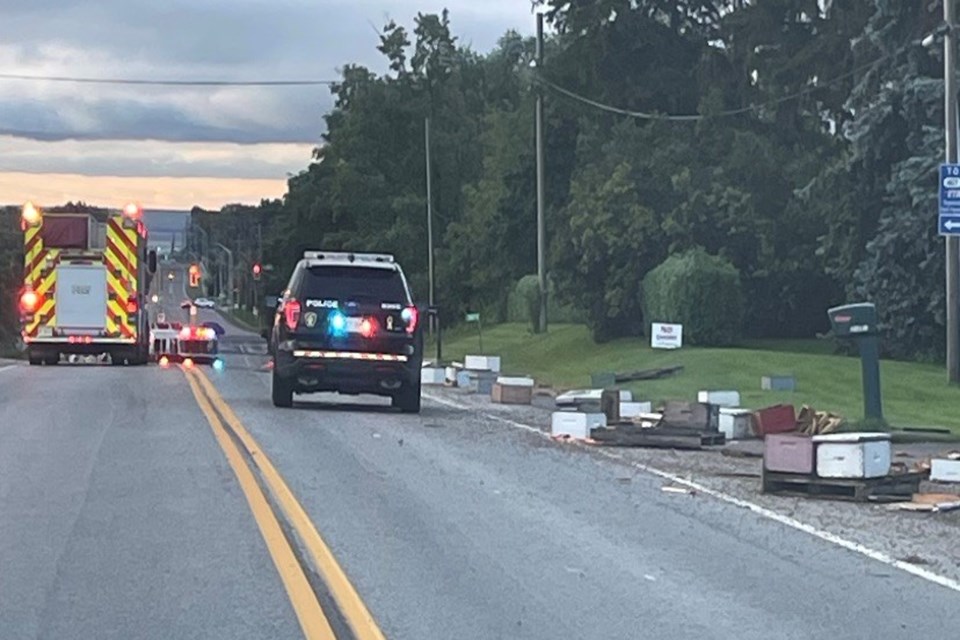Approximately five million bees were buzzing around Guelph Line north of Dundas Street this morning.
Crates carrying the bees fell off the back of a truck and into the road sometime between 5 and 6 a.m. Wednesday (Aug. 30), and clean up got underway quickly.
Fire crews and police officers were called to the scene, as well as several beekeepers. The clean-up crew used smokers to calm the bees and get them back into the crates before transporting them.
There were still two bee crates on the side of the road as of 1 p.m., and the bees have swarmed onto a nearby mailbox as well. The remainder of the crates have been loaded onto a trailer a few hundred feet from where they initially fell.
Tens of thousands of bees are lying dead on the road, while hundreds of thousands continue to fly around the trailer.
“The only injuries so far have been to the initial beekeeper on the scene,” Halton police communications officer Ryan Anderson told BurlingtonToday. “The beekeeper was stung pretty significantly and had to be checked out by EMS, but they were not transported to hospital.”
Guelph Ln north of Dundas - Officers dealing with load of 5 million bees fallen off truck onto roadway. Passing vehicles/residents advised to close windows & pedestrians avoid area until clear. ^jwf pic.twitter.com/evuVoyL1Fc
— HRPS Burlington (@HRPSBurl) August 30, 2023
For anyone who is not allergic, it takes a surprising amount of stings before a real emergency can happen, Dave Stotesbury, beekeeper with Backed By Bees, says.
“Your body should be able to tolerate 10 stings for every pound of body weight,” Stotesbury says. “For myself, at 190 pounds, it would take 1,900 bee stings before I have any really serious issues.”
Beekeepers arrived to help with the clean-up effort, but residents were advised to avoid the area until about 9:45 a.m. Police and keepers planned to leave some bee crates behind so straggler insects can find their way back. The remaining crates are expected to be picked up sometime this evening.
By around 11 a.m., it was safe to drive through the area with the windows up, but police asked residents to avoid walking, and to avoid approaching the crates.
A full clean up may take some time, depending on just how badly the crates were damaged during the fall.
“It’s never perfect, you’re never going to get every single bee because some of them will be in the air,” Stotesbury says. “At some larger spills, you have to bring in pheromone attractants to get the bees to congregate in certain areas.”
Transporting bees is a race against public safety, given the risk of bees escaping or the event of the crates breaking, Stotesbury says. Getting the bees out of the way of the public is the first priority.
The faster the bees are collected, the less of a risk there is for losses.
“The longer they’re out there, the more likely to fly away and become a public nuisance,” Stotesbury says.
It is still not known where the bees came from, or where they were going. A crate – or colony – can hold anywhere between 40,000 and 80,000 bees, depending on the size. Depending on the purpose of the bees, transporting five million at a time is not unusual.
“For someone in the pollination world, that’s a fairly small number of bees,” Stotesbury says. “But if we’re talking about someone in the hobby beekeeping world, that is huge. If each colony had 50,000 bees, that would be 100 colonies.”



